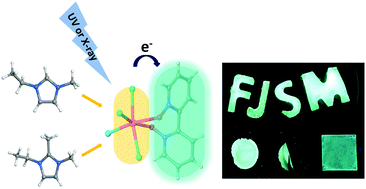Long lifetime phosphorescence and X-ray scintillation of chlorobismuthate hybrids incorporating ionic liquid cations†
Abstract
Two chlorobismuthate hybrids incorportating ionic liquid cations (ILCs) with second-level room-temperature phosphorescence (RTP), namely [Emim]BiCl4(bp2do) (1) and [Emmim]BiCl4(bp2do) (2) (Emim = 1-ethyl-3-methylimidazolium, Emmim = 1-ethyl-2,3-dimethylimidazolium, bp2do = 2,2′-bipyridyl-1,1′-dioxide), were obtained. The decrease in the number of substituents in the ILCs largely enhanced the phosphorescence quantum yield (QY) from 2.31% for 2 to 25.05% for 1, owing to the more compact structure of 1. The two compounds possess uncommonly different temperature-dependent emission peak shifting behaviors, which could be ascribed to whether the electron-phonon interactions or the exciton localization at high energy is dominant. Density functional theory (DFT) calculations show that the optical absorptions for both compounds originate from inorganic moiety to organic moiety charge transfer (IOCT). X-ray scintillation was observed for both compounds, which is the first report on inorganic–organic halobismuthate hybrids. Finally, 1 with higher QY was fabricated into a luminescent thin flim, letters and a bendable round wafer with polyacrylonitrile (PAN). This work provides new insight on RTP materials and X-ray scintillation materials involving bismuth halides.



 Please wait while we load your content...
Please wait while we load your content...